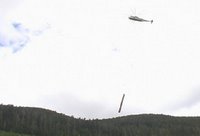 Local mountains are home to the last of one of the world’s rarest mammals, Marmota vancouverensis, commonly known as the Vancouver Island Marmot. Today less than 80 live in the wild.
Local mountains are home to the last of one of the world’s rarest mammals, Marmota vancouverensis, commonly known as the Vancouver Island Marmot. Today less than 80 live in the wild. These cute fuzzy rodents are indigenous to Vancouver Island and live in sub-alpine meadows above 1000 meters where their preferred food is the flowers of low growing plants. They dig burrows under boulders which protect them from the elements and predators. They only venture out from their burrows at dawn and dusk to feed and play. In winter they hibernate deep below the snow.
Vancouver Island's largest marmot colony during the past 20 years, on Green Mountain near Courtney, went extinct in 2001. A foundation was set up to try and re-populate the region, spending $900,000 annually in this endeavor. 80 marmots have been bred in captivity near Calgary, however raising wild animals in enclosures does not prepare them for survival in the wild.
After being released from cages by BC Parks officials the young marmots are free at last to scurry through the natural vegetation, revel in the abundance of fresh flowers, and look out over the alpine meadow from rocky outcroppings. Then a predator lands on them and they become a part of the natural food chain. This has happened repeatedly.
In 2002-2003 the Ministry of WLAP acted on the BC Liberal’s 30% predator cull strategy to protect the Vancouver Island Marmot. Several deer carcasses were set as bait in the alpine meadows of Green Mountain. Men with high powered guns lay in wait, then shot and killed a total of six Golden Eagles.
Named for its beautiful dark golden brown plumage the Golden Eagle is larger than the Bald Eagle with a wingspan anywhere from 6 to 8 feet. Golden Eagles are protected in the United States through the US Fish and Wildlife Service. Possession of a feather or other body part is a felony with a fine of up to $10,000 and/or 10 years in prison.
It is illegal to shoot an Eagle in BC yet the Liberal government contracted men to kill 6 of these birds. BC Parks also trapped and killed 11 wolves and 5 cougar, in the vicinity of Green Mountain. The number of bear shot to protect this colony remains unknown. Island predator count estimates are based on the reports of hunter sightings. Is that sound and solid scientific evidence? Although the Marmot Recovery Team openly supports the culling of predators, they deny any responsibility or participation in the culling process because that was a matter for the government to administrate.
Most government and corporate reports would have the public believe that logging corporations are the saviors of these little critters and government is protecting them by shooting the ‘big bad’ predators. How many predators will be shot before they too are considered endangered? Through the power of ‘spin doctors’ the marmots have become a symbol of the logging industry’s compassion for the environment while the species comes ever closer to extinction.
The reality is that logging has devastated the forests of Vancouver Island. A maze of logging roads, clear-cuts, and eroded slopes has destroyed the natural corridors that connect various mountains. Marmots live in very small colonies of 10 to 20 animals. To avoid interbreeding the young males travel between colonies which are often mountains apart.
These small travelers rely upon the natural forested range to provide hiding places as well as the occasional open area where wild flowers can be eaten during the long journey. Logging has ripped open these natural corridors between mountains making it easier for predators to kill marmots. Helicopter logging makes it increasingly more dangerous for marmots as sub-alpine forests are cut down.
A recent photo opportunity highlighting the release of marmots shows that BC’s newly appointed Minister of Environment, Barry Penner, is very much aware of the ‘spin’ value of marmots. If you have questions please contact: barry.penner.mla@leg.bc.ca
